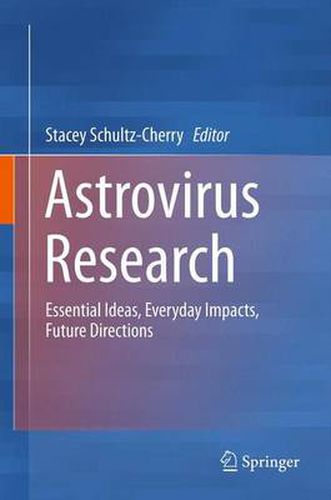Readings Newsletter
Become a Readings Member to make your shopping experience even easier.
Sign in or sign up for free!
You’re not far away from qualifying for FREE standard shipping within Australia
You’ve qualified for FREE standard shipping within Australia
The cart is loading…






This title is printed to order. This book may have been self-published. If so, we cannot guarantee the quality of the content. In the main most books will have gone through the editing process however some may not. We therefore suggest that you be aware of this before ordering this book. If in doubt check either the author or publisher’s details as we are unable to accept any returns unless they are faulty. Please contact us if you have any questions.
Astroviruses were first identified in the feces of children in 1975. Since then, they have been found in ~ 3 to 20% of children with diarrhea. Given that serological studies have demonstrated that up to 90% of children have been exposed to at least one strain of astrovirus by age 9, the prevalence of infection may be much higher. Supporting this are studies demonstrating that astroviruses can also be isolated in a subset of asymptomatic individuals, suggesting that a proportion of infected individuals shed the virus asymptomatically or for some time after the resolution of other symptoms of infection. Asymptomatic carriers may be a major reservoir for astroviruses in the environment and could contribute to dissemination of the virus. Astroviruses are extremely stable in the environment and can be transmitted nosocomially, directly from infected individuals and potentially animals, and through contaminated food and water. Although typically an acute disease, astrovirus infection in premature infants may be associated with the development of necrotizing enterocolitis and in new-onset celiac disease in children. Immunocompromised children are even more susceptible often developing persistent infections that lead to wasting or even systemic infections associated with fatal encephalitis.
In spite of its importance, little is known about astrovirus pathogenesis, molecular biology, epidemiology, or cell biology. The goal of this book is to provide the latest and most up-to-date information on this medically important and rapidly evolving group of viruses. It will include sections on the history of astroviruses and their disease in humans; information on viral replication and immune responses; new information on how astroviruses induce disease including the expression of a viral enterotoxin regulating intestinal epithelial cell tight junctions, the isolation and identification of new astrovirus genotypes in mammals including humans, and astroviruses of veterinary importance. Finally, the book will also introduce the complexity of astrovirus epidemiology and potential as an important new zoonotic disease, and its role in food-borne disease. This will be the first book of its kind and will be of great interest to microbiologists, virologists, infectious disease specialists, immunologists, pediatricians, public health and food safety experts, veterinarians, poultry industry specialists, and researchers and clinicians interested in enteritis.
$9.00 standard shipping within Australia
FREE standard shipping within Australia for orders over $100.00
Express & International shipping calculated at checkout
This title is printed to order. This book may have been self-published. If so, we cannot guarantee the quality of the content. In the main most books will have gone through the editing process however some may not. We therefore suggest that you be aware of this before ordering this book. If in doubt check either the author or publisher’s details as we are unable to accept any returns unless they are faulty. Please contact us if you have any questions.
Astroviruses were first identified in the feces of children in 1975. Since then, they have been found in ~ 3 to 20% of children with diarrhea. Given that serological studies have demonstrated that up to 90% of children have been exposed to at least one strain of astrovirus by age 9, the prevalence of infection may be much higher. Supporting this are studies demonstrating that astroviruses can also be isolated in a subset of asymptomatic individuals, suggesting that a proportion of infected individuals shed the virus asymptomatically or for some time after the resolution of other symptoms of infection. Asymptomatic carriers may be a major reservoir for astroviruses in the environment and could contribute to dissemination of the virus. Astroviruses are extremely stable in the environment and can be transmitted nosocomially, directly from infected individuals and potentially animals, and through contaminated food and water. Although typically an acute disease, astrovirus infection in premature infants may be associated with the development of necrotizing enterocolitis and in new-onset celiac disease in children. Immunocompromised children are even more susceptible often developing persistent infections that lead to wasting or even systemic infections associated with fatal encephalitis.
In spite of its importance, little is known about astrovirus pathogenesis, molecular biology, epidemiology, or cell biology. The goal of this book is to provide the latest and most up-to-date information on this medically important and rapidly evolving group of viruses. It will include sections on the history of astroviruses and their disease in humans; information on viral replication and immune responses; new information on how astroviruses induce disease including the expression of a viral enterotoxin regulating intestinal epithelial cell tight junctions, the isolation and identification of new astrovirus genotypes in mammals including humans, and astroviruses of veterinary importance. Finally, the book will also introduce the complexity of astrovirus epidemiology and potential as an important new zoonotic disease, and its role in food-borne disease. This will be the first book of its kind and will be of great interest to microbiologists, virologists, infectious disease specialists, immunologists, pediatricians, public health and food safety experts, veterinarians, poultry industry specialists, and researchers and clinicians interested in enteritis.